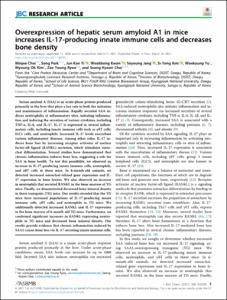Full metadata record
| DC Field | Value | Language |
|---|---|---|
| dc.contributor.author | Choi, Minjee | - |
| dc.contributor.author | Park, Song | - |
| dc.contributor.author | Yi, Jun Koo | - |
| dc.contributor.author | Kwon, Wook bong | - |
| dc.contributor.author | Jang, So young | - |
| dc.contributor.author | Kim, Si Yong | - |
| dc.contributor.author | Yu, Wookyung | - |
| dc.contributor.author | Kim, Myoung Ok | - |
| dc.contributor.author | Ryoo, Zae Young | - |
| dc.contributor.author | Choi, Seong-Kyoon | - |
| dc.date.accessioned | 2021-09-28T01:00:03Z | - |
| dc.date.available | 2021-09-28T01:00:03Z | - |
| dc.date.created | 2021-05-04 | - |
| dc.date.issued | 2021-01 | - |
| dc.identifier.issn | 0021-9258 | - |
| dc.identifier.uri | http://hdl.handle.net/20.500.11750/15339 | - |
| dc.description.abstract | Serum amyloid A (SAA) is an acute-phase protein produced primarily in the liver that plays a key role in both the initiation and maintenance of inflammation. Rapidly secreted SAA induces neutrophilia at inflammatory sites, initiating inflammation and inducing the secretion of various cytokines, including TNF-α, IL-6, and IL-17. IL-17 is expressed in several inflammatory cells, including innate immune cells such as γδT cells, ILC3 cells, and neutrophils. Increased IL-17 levels exacerbate various inflammatory diseases. Among other roles, IL-17 induces bone loss by increasing receptor activator of nuclear factor-κB ligand (RANKL) secretion, which stimulates osteoclast differentiation. Several studies have demonstrated that chronic inflammation induces bone loss, suggesting a role for SAA in bone health. To test this possibility, we observed an increase in IL-17-producing innate immune cells, neutrophils, and γδT cells in these mice. In 6-month-old animals, we detected increased osteoclast-related gene expression and IL- 17 expression in bone lysates. We also observed an increase in neutrophils that secreted RANKL in the bone marrow of TG mice. Finally, we demonstrated decreased bone mineral density in these transgenic (TG) mice. Our results revealed that the TG mice have increased populations of IL-17-producing innate immune cells, γδT cells, and neutrophils in TG mice. We additionally detected increased RANKL and IL-17 expression in the bone marrow of 6-month-old TG mice. Furthermore, we confirmed significant increases in RANKL-expressing neutrophils in TG mice and decreased bone mineral density. Our results provide evidence that chronic inflammation induced by SAA1 causes bone loss via IL-17-secreting innate immune cells. © 2021 American Society for Biochemistry and Molecular Biology Inc.. All rights reserved. | - |
| dc.language | English | - |
| dc.publisher | American Society for Biochemistry and Molecular Biology Inc. | - |
| dc.title | Overexpression of hepatic serum amyloid A1 in mice increases IL-17-producing innate immune cells and decreases bone density | - |
| dc.type | Article | - |
| dc.identifier.doi | 10.1016/j.jbc.2021.100595 | - |
| dc.identifier.scopusid | 2-s2.0-85104650865 | - |
| dc.identifier.bibliographicCitation | Journal of Biological Chemistry, v.296, pp.100595 | - |
| dc.description.isOpenAccess | TRUE | - |
| dc.subject.keywordPlus | Gene expression | - |
| dc.subject.keywordPlus | Glycoproteins | - |
| dc.subject.keywordPlus | Mammals | - |
| dc.subject.keywordPlus | Pathology | - |
| dc.subject.keywordPlus | Proteins | - |
| dc.subject.keywordPlus | Acute phase proteins | - |
| dc.subject.keywordPlus | Bone mineral density | - |
| dc.subject.keywordPlus | Chronic inflammation | - |
| dc.subject.keywordPlus | Inflammatory cells | - |
| dc.subject.keywordPlus | Inflammatory disease | - |
| dc.subject.keywordPlus | Nuclear factor kappaB | - |
| dc.subject.keywordPlus | Osteoclast differentiation | - |
| dc.subject.keywordPlus | Receptor activator | - |
| dc.subject.keywordPlus | Cytology | - |
| dc.citation.startPage | 100595 | - |
| dc.citation.title | Journal of Biological Chemistry | - |
| dc.citation.volume | 296 | - |
- Files in This Item:
-
 기타 데이터 / 2.39 MB / Adobe PDF
download
기타 데이터 / 2.39 MB / Adobe PDF
download



